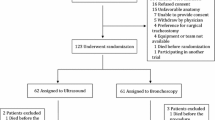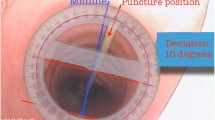Abstract
Patients in ICUs frequently require tracheostomy for long-term ventilator support, and the percutaneous dilatational tracheostomy (PDT) method is preferred over surgical tracheostomy. The use of ultrasound (US) imaging to guide ICU procedures and interventions has recently emerged as a simple and noninvasive tool. The current evidence regarding the applications of US in PDT is encouraging; however, the exact role of US-guided dilatational tracheostomy (US-PDT) remains poorly defined. In this review, we describe the best available evidence concerning the safety and efficacy of US-PDT and briefly delineate the general principles of US image generation for the airway and of US-PDT procedures.





Similar content being viewed by others
Abbreviations
- A-M:
-
Air-mucosal
- PDT:
-
Percutaneous dilatational tracheostomy
- RCT:
-
Randomised controlled trial
- US:
-
Ultrasound
- US-PDT:
-
Ultrasound-guided percutaneous dilatational tracheostomy
- USS:
-
Ultrasound scanning
References
Delaney A, Bagshaw SM, Nalos M. Percutaneous dilatational tracheostomy versus surgical tracheostomy in critically ill patients: a systematic review and meta-analysis. Crit Care. 2006;10:R55.
Needham DM, Bronskill SE, Calinawan JR, Sibbald WJ, Pronovost PJ, Laupacis A. Projected incidence of mechanical ventilation in Ontario to 2026: preparing for the aging baby boomers. Crit Care Med. 2005;33:574–9.
Zilberberg MD, de Wit M, Pirone JR, Shorr AF. Growth in adult prolonged acute mechanical ventilation: implications for healthcare delivery. Crit Care Med. 2008;36:1451–5.
Higgins KM, Punthakee X. Meta-analysis comparison of open versus percutaneous tracheostomy. Laryngoscope. 2007;117:447–54.
Massick DD, Yao S, Powell DM, Griesen D, Hobgood T, Allen JN, et al. Bedside tracheostomy in the intensive care unit: a prospective randomized trial comparing open surgical tracheostomy with endoscopically guided percutaneous dilational tracheotomy. Laryngoscope. 2001;111:494–500.
Das P, Zhu H, Shah RK, Roberson DW, Berry J, Skinner ML. Tracheotomy related catastrophic events: results of a national survey. Laryngoscope. 2012;122:30–7.
Simon M, Metschke M, Braune SA, Püschel K, Kluge S. Death after percutaneous dilatational tracheostomy: a systematic review and analysis of risk factors. Crit Care. 2013;17:R258.
McCormick B, Manara AR. Mortality from percutaneous dilatational tracheostomy. A report of three cases. Anaesthesia. 2005;60:490–5.
Sarkar S, Kelly A, Townsend R. Survey of percutaneous tracheostomy practice in UK intensive care units. JICS. 2009;10:138–40.
Kluge S, Baumann HJ, Maier C, Klose H, Meyer A, Nierhaus A, et al. Tracheostomy in the intensive care unit: a nationwide survey. Anesth Analg. 2008;107:1639–43.
Trottier SJ, Hazard PB, Sakabu SA, Levine JH, Troop BR, Thompson JA, et al. Posterior tracheal wall perforation during percutaneous dilatational tracheostomy: an investigation into its mechanism and prevention. Chest. 1999;115:1383–9.
Reilly PM, Shapiro MB, Malcynski JT. Percutaneous dilatational tracheostomy under the microscope: justification for intra-procedural bronchoscopy? Intensive Care Med. 1999;25:3–4.
Reilly PM, Anderson III HL, Sing RF, Schwab W, Bartlett RH. Occult hypercarbia: an unrecognized phenomenon during percutaneous endoscopic tracheostomy. Chest. 1995;107:760–3.
Reilly PM, Sing RF, Giberson FA, Anderson III HL, Rotondo MF, Tinkoff GH, et al. Hypercarbia during tracheostomy: a comparison of percutaneous endoscopic, percutaneous Doppler, and standard surgical tracheostomy. Intensive Care Med. 1997;23:858–64.
Paran H, Butnaru G, Hass I, Afanasyv A, Gutman M. Evaluation of a modified percutaneous tracheostomy technique without bronchoscopic guidance. Chest. 2004;126:868–71.
Elliott DS, Baker PA, Scott MR, Birch CW, Thompson JM. Accuracy of surface landmark identification for cannula cricothyroidotomy. Anaesthesia. 2010;65:889–94.
Australian New Zealand Intensive Care Society (ANZICS). Percutaneous Dilatational Tracheostomy – Consensus Statement. Carlton, South Victoria: Australian New Zealand Intensive Care Society; 2014. http://www.anzics.com.au/Downloads/2014%20The%20ANZICS%20Percutaneous%20Dilatational%20Tracheostomy%20Consensus%20Statement.pdf.
Husein OF, Massick DD. Cricoid palpability as a selection criterion for bedside tracheostomy. Otolaryngol Head Neck Surg. 2005;133:839–44.
Byhahn C, Lischke V, Meininger D, Halbig S, Westphal K. Perioperative complications during percutaneous tracheostomy in obese patients. Anaesthesia. 2005;60:12.
Pearson N, Huebner K. The use of ultrasound guidance for cricothyroidotomy in three simulated cadaveric difficult airway models. Ann Emerg Med. 2012;3:159.
Dinsmore J, Heard AM, Green RJ. The use of ultrasound to guide time-critical cannula tracheotomy when anterior neck airway anatomy is unidentifiable. Eur J Anaesthesiol. 2011;28:506–10.
Sustić A, Zupan Z, Antoncić I. Ultrasound-guided percutaneous dilatational tracheostomy with laryngeal mask airway control in a morbidly obese patient. J Clin Anesth. 2004;16:121–3.
Baumber R. Neck ultrasound prior to percutaneous tracheostomy: should this now be a standard of practice? J Intens Care Soc. 2011;12:342.
Guinot PG, Zogheib E, Petiot S, Marienne JP, Guerin AM, Monet P, et al. Ultrasound-guided percutaneous tracheostomy in critically ill obese patients. Crit Care. 2012;16:R40.
Shlugman D. Acute fatal haemorrhage during percutaneous dilatational tracheostomy. Br J Anaesth. 2003;90:517–20.
Sustić A, Zupan Z, Eskinja N, Dirlić A, Bajek G. Ultrasonographically guided percutaneous dilatational tracheostomy after anterior cervical spine fixation. Acta Anaesthesiol Scand. 1999;43:1078–80.
Bertram S, Emshoff R, Norer B. Ultrasonographic anatomy of the anterior neck: implications for tracheostomy. J Oral Maxillofacial Surg. 1995;53:1420–4.
Tremblay LN, Scales DC. Ultrasound-guided tracheostomy - not for the many, but perhaps the few… or the one. Crit Care. 2011;15:147.
Hatfield A, Bodenham A. Portable ultrasonic scanning of the anterior neck before percutaneous dilatational tracheostomy. Anaesthesia. 1999;54:660–3.
Flint AC, Midde R, Rao VA, Lasman TE, Ho PT. Bedside ultrasound screening for pretracheal vascular structures may minimize the risks of percutaneous dilatational tracheostomy. Neurocrit Care. 2009;11:372–6.
Chacko J, Nikahat J, Gagan B, Umesh K, Ramanathan M. Realtime ultrasound-guided percutaneous dilatational tracheostomy. Intensive Care Med. 2012;38:920–1.
Sustić A, Krstulovic B, Eskinja N, Zelic M, Ledic D, Turina D. Surgical tracheostomy versus percutaneous dilational tracheostomy in patients with anterior cervical spine fixation: preliminary report. Spine (Phila Pa 1976). 2002;27:1942–5.
Sustić A. Role of ultrasound in the airway management of critically ill patients. Crit Care Med. 2007;35:137–77.
Sustić A, Kovac D, Zgaljardić Z, Zupan Z, Krstulović B. Ultrasound-guided percutaneous dilatational tracheostomy: a safe method to avoid cranial misplacement of the tracheostomy tube. Intensive Care Med. 2000;26:1379–81.
McFarlane C, Denholm SW, Sudlow CL, Moralee SJ, Grant IS, Lee A. Laryngotracheal stenosis: a serious complication of percutaneous tracheostomy. Anaesthesia. 1994;49:38–40.
Van Heurn LW, Theunissen PH, Ramsay G, Brink PR. Pathologic changes of the trachea after percutaneous dilatational tracheostomy. Chest. 1996;109:1466–9.
Walz MK, Schmidt U. Tracheal lesion caused by percutaneous dilatational tracheostomy - a clinico-pathological study. Intensive Care Med. 1999;25:102–5.
Sarper A, Ayten A, Eser I, Ozbudak O, Demircan A. Tracheal stenosis after tracheostomy or intubation: review with special regard to cause and management. Texas Heart Institute J. 2005;32:154–8.
Bonde J, Nørgaard N, Antonsen K, Faber T. Implementation of percutaneous dilation tracheotomy - value of preincisional ultrasonic examination? Acta Anaesthesiol Scand. 1999;43:163–6.
Szeto C, Kost K, Hanley JA, Roy A, Christou N. A simple method to predict pretracheal tissue thickness to prevent accidental decannulation in the obese. Otolaryngol Head Neck Surg. 2010;143:223–9.
Ambesh SP. Principles and Practice of Percutaneous Tracheostomy. Croatia: Jaypee Brothers Medical Publisher; 2010.
Kundra P, Mishra SK, Ramesh A. Ultrasound of the airway. Indian J Anaesth. 2011;55:456–62.
Kollig E, Heydenreich U, Roetman B, Hopf F, Muhr G. Ultrasound and bronchoscopic controlled percutaneous tracheostomy on trauma ICU. Injury. 2000;31:663–8.
Lichtenstein DA, Mezière G, Lascols N, Biderman P, Courret JP, Gepner A, et al. Ultrasound diagnosis of occult pneumothorax. Crit Care Med. 2005;33:1231–8.
Kaya SO, Karatepe M, Tok T, Onem G, Dursunoglu N, Goksin I. Were pneumothorax and its management known in 15th-century anatolia? Tex Heart Inst J. 2009;36:152–3.
Rajajee V, Fletcher JJ, Rochlen LR, Jacobs TL. Real-time ultrasound-guided percutaneous dilatational tracheostomy: a feasibility study. Crit Care. 2011;15:R67.
Rudas M, Seppelt I, Herkes R, Hislop R, Rajbhandari D, Weisbrodt L. Traditional landmark versus ultrasound guided tracheal puncture during percutaneous dilatational tracheostomy in adult intensive care patients: a randomised controlled trial. Crit Care. 2014;18:514.
Yavuz A, Yılmaz M, Göya C, Alimoglu E, Kabaalioglu A. Advantages of US in percutaneous dilatational tracheostomy: randomized controlled trial and review of the literature. Radiology. 2014;273:927–36.
Hangiandreou N. AAPM/RSNA physics tutorial for residents: topics in US. B-mode US: basic concepts and new technology. Radiographics. 2003;23:1019–33.
Noble VE, Nelson B, Sutingco AN. Manual of Emergency and Critical Care Ultrasound. New York: Cambridge University Press; 2007.
Singh M, Chin KJ, Chan VW, Wong DT, Prasad GA, Yu E. Use of sonography for airway assessment: an observational study. J Ultrasound Med. 2010;29:79–85.
Sites BD, Brull R, Chan VW, Spence BC, Gallagher J, Beach ML, et al. Artifacts and pitfall errors associated with ultrasound-guided regional anesthesia. Part II: a pictorial approach to understanding and avoidance. Reg Anesth Pain Med. 2007;32:419–33.
Kossoff G. Basic physics and imaging characteristics of ultrasound. World J Surg. 2000;24:134–42.
Rudas M. The role of ultrasound in percutaneous dilatational tracheostomy. AJUM. 2012;15:143–8.
Praveen CV, Martin A. A rare case of fatal haemorrhage after tracheostomy. Ann R Coll Surg Engl. 2007;89:W6–8.
Della Puppa A, Pittoni G. Inferior thyroid artery bleeding: a life-threatening complication of non-surgical tracheostomy. Minerva Anestesiol. 2001;67:483–5.
Kleine-Brueggeney M, Greif R, Ross S, Eichenberger U, Moriggl B, Arnold A, et al. Ultrasound-guided percutaneous tracheal puncture: a computer-tomographic controlled study in cadavers. Br J Anaesthesia. 2011;106:738–42.
Kost KM. Endoscopic percutaneous dilatational tracheotomy: a prospective evaluation of 500 consecutive cases. Laryngoscope. 2005;115:1–30.
Rezende-Neto JB, Oliveira AJ, Neto MP, Botoni FA, Rizoli SB. A technical modification for percutaneous tracheostomy: prospective case series study on one hundred patients. World J Emerg Surg. 2011;6:35.
Dunne K, Ball D, Jefferson P. Cannula cricothyroidotomy: management of false-negative aspiration. Anaesthesia. 2009;64:1375.
Acknowledgements
The work was supported by the College of Medicine Research Centre and the Deanship of Scientific Research, King Saud University Riyadh, Saudi Arabia. The images were reproduced with the permission of the Indian Journal of Anaesthesia.
Author information
Authors and Affiliations
Corresponding author
Additional information
Competing interests
The authors declare that they have no competing interests. The subject of this review has no connections with any company or financial sponsor.
Authors’ contributions
MA conceived of the idea and participated in the literature review, the drafting of the manuscript, and the revision for important intellectual content. HA participated in the literature review and the drafting of the manuscript. ZA participated in the literature review and added a small section and then contributed to the final revision, including the English editing. MAE helped to collect images and participated in the literature review and the drafting of the manuscript. All authors read and approved the final manuscript.
Rights and permissions
About this article
Cite this article
Alansari, M., Alotair, H., Al Aseri, Z. et al. Use of ultrasound guidance to improve the safety of percutaneous dilatational tracheostomy: a literature review. Crit Care 19, 229 (2015). https://doi.org/10.1186/s13054-015-0942-5
Published:
DOI: https://doi.org/10.1186/s13054-015-0942-5




